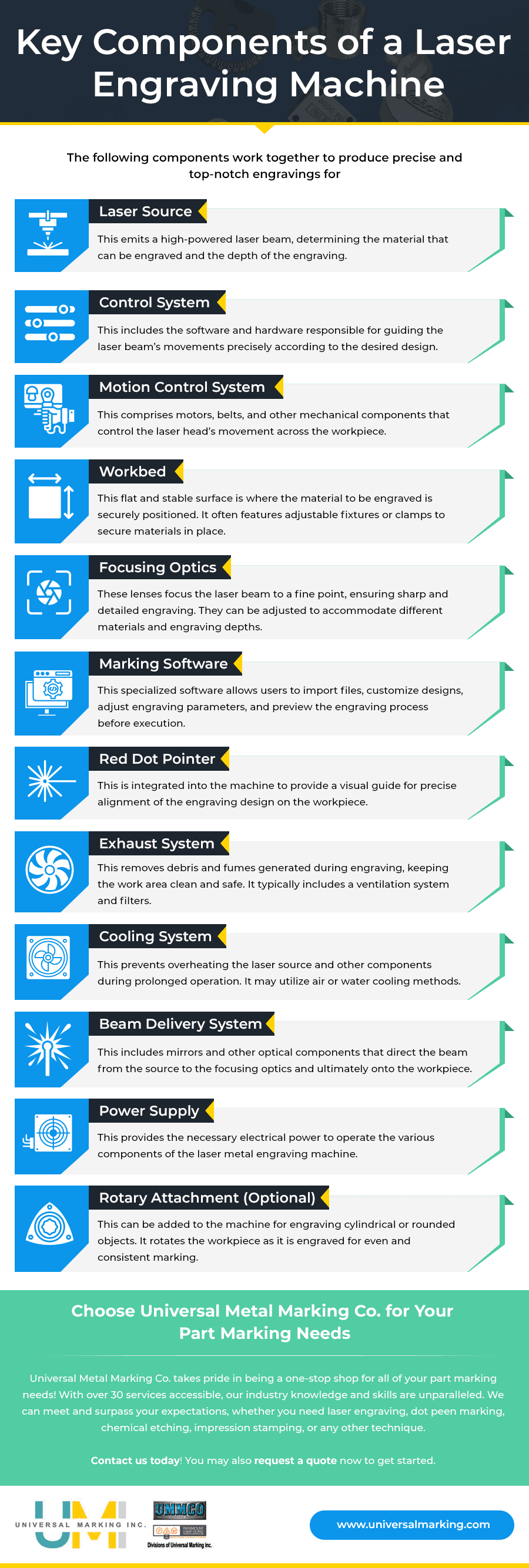In modern manufacturing, parts need to be permanently marked with a variety of text and designs like serial or batch numbers for traceability, witness marks and reference lines to aid assembly, and manufacturer name, logo, or QR code.
While many options exist for marking parts, electrochemical etching is a great choice because it makes precise, visually crisp, easily-read markings that are permanent and do not damage parts. Learn how this efficient, cost-effective method works and how it is used in industry.
What Is Electrochemical Etching?
Electrochemical etching uses a flow of electricity and electrolytic solution (i.e., metallic salt) to remove a thin layer from the surface of a metal workpiece. There are two primary methods:
- Electrolyte bath method. Here the workpiece is submerged in a bath of electrolyte solution (i.e., a matching metallic salt). Any exposed metal will be etched, so vinyl or other non-conductive material (i.e., the “resist”) is applied to cover areas that should not be etched. An electrode is attached to the workpiece (i.e., anode) and to another “sacrificial” piece of metal (i.e., the cathode). Current runs through the solution, causing ions to be removed from the anode and deposited on the cathode.
- Etching machine method. This works on the same principle; however, the resist material is soaked with electrolyte solution and applied to the workpiece instead of submerging it in solution. Exposed areas serve as the cathode, while the covered area is the anode. Current is applied and ions are removed from the anode, leaving the text or design on the piece when the stencil is removed.
How Does Electrochemical Etching by Machine Work?
Electricity is applied to the workpiece and causes ions to be removed from the area to be etched (called the anode). Only the area or areas of the workpiece in contact with the electrolyte solution will give up ions and become etched. It’s possible to create light or dark etching for different effects, and adjust cycle time to etch to different depths.
The process involves these steps:
- Stencil and mask printing. The text or design is printed on a stencil.
- Surface preparation. The workpiece is cleaned and degreased to neutralize the surface and help the stencil stay in place.
- Electrolyte fluid application and stencil positioning. An electrolyte is selected and applied to the stencil, then the stencil is positioned on the piece.
- Etching. An electrode is passed over the stencil while releasing an electrical current, which causes the areas in contact with the solution to give up ions and create the etched design.
- Neutralization. A special neutralizer is applied to the workpiece to remove the electrolyte and prepare the piece for additional finishing or packaging.
Benefits of Electrochemical Etching
Other marking and etching techniques exist, such as laser etching, chemical etching, or embossing; however, electrolytic etching processes have several advantages, including:
- Extremely clear markings that can be etched to a specific depth.
- Excellent resolution for fine details, intricate patterns, and small fonts.
- Damage-free process that does not create a heat-affected zone, dent or deform parts, or cause corrosion.
- Suitable for a variety of metals including aluminum, copper, stainless steel, and titanium.
- Permanent markings without rust or discoloration.
- Fast and cost-effective.
Common Applications for Electrochemical Etching
Electrochemical etching is used in many industries to mark serial numbers and identifying details on parts, as well as for branding and adding assembly markings. Common applications include, but are not limited to:
Automotive
Vehicle parts and components are marked with part numbers, serial numbers, branding info, and more for purposes of traceability and quality assurance. Because electrochemical etchings do not fade, they can stand up to extreme temperatures and chemical exposure in these applications.
Aerospace
Similar to the automotive industry, aerospace components require durable, high-resolution markings as well.
Medical Devices
Medical device manufacturers use electrochemical etching to mark components with identifying details and numbers that won’t fade away. This may include surgical tools and instruments, implantable components, and medical equipment. And unlike labels or printed designs, etchings also won’t interfere with the critical functions of medical devices, which is safer for patients.
Electronics Manufacturing
Serial number etchings on electronic devices and components help with long-term traceability and identification. It is also possible to etch electrical pathways for circuit boards, connectors, and semiconductors, especially as electronics become increasingly tiny and complex. The markings withstand heat from soldering and do not rust.
Electrochemical Etching at Universal Marking, Inc.
Electrochemical etching is used across industries to create permanent, clear markings that help identify parts and assemblies, add visual effects and branding, and support supply chain traceability. At Universal Marking, Inc., we specialize in high-precision electrochemical etching and other precision etching and marking services so you can mark parts and products exactly as needed.
Contact us today to discuss your requirements, or request a quote for pricing details.

